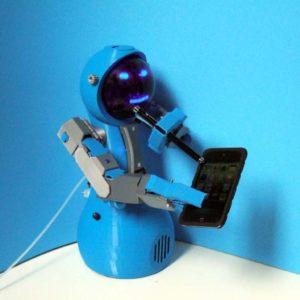
This has proven to be the case yet again with Zizzy, the personal robot created to assist those with limited mobility. The project, which was created by Michael Roybal, took about a year to design and develop, the end product being a 3D printed robot capable of talking, showing emotion, and manipulating food, water, and communication devices. The most intriguing part of Zizzy is the 3D printed pneumatic artificial muscles, which are created with hollow bellows printed out of NinjaFlex. These 3D printed muscles are painted with fabric glue and MEK solvent, and should be capable of holding 20 PSI without an issue.
In addition, the head, body, arms, mounting brackets, air control valves, as well as the artificial muscles that actuate the two arms and grippers are all 3D printable. Roybal has made his 3D printed robot project available on Instructables, and it’s entirely comprised of open source hardware and software. Essentially, Zizzy will utilize its two arms to help pick up objects like medicine, food, and smartphone devices, and will carry them over to those with mobility issues. The robot will be able to be remote controlled or function autonomously, while an infrared remote could be utilized to interface with a wheelchair or another type of controller.
Zizzy’s modular construction allows the user to create and update new muscles and grippers, while the talking circuit and master robot neuron are also able to be modified and plugged back in. As of now, Zizzy’s face is not yet fully functional, while more extensive vocabulary needs to be integrated as well. Roybal is also working to design a new arm exoskeleton to enable the 3D printed robot to move each joint 80 degrees, a vast improvement over the 48 degrees of motion that the current design allows for. He’s also designed a larger and much stronger gripper and muscle that will be integrated with one another.
All in all, Zizzy adds legitimacy to the claim that 3D printing technology is the optimal medium for the development of robotics. Not only does 3D printing enable Roybal to create the initial prototype, but also to redesign and improve the artificial muscles and other components. Ultimately, the 3D printed robot offers a helpful and friendly service to those needing mobility assistance, and will continue to improve itself and its user as time goes on. Discuss further over in the Zizzy 3D Printed Robot forum at 3DPB.com.
[Source: Hackaday]